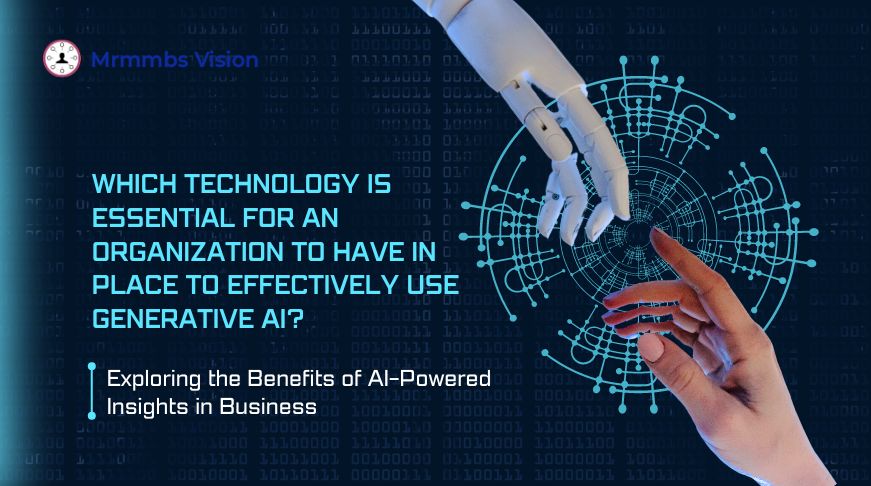
Which technology is essential for an organization to have in place to effectively use generative ai?
What is generative AI
Generative AI is a sort of artificial intelligence technology that can generate a variety of content, such as text, images, audio, and synthetic data. The recent enthusiasm surrounding generative AI has been fueled by the ease with which new user interfaces can produce high-quality text, pictures, and movies in seconds.
How does generative AI work?
Generative AI begins with a prompt, which can take the form of text, an image, a video, a design, musical notes, or any other input that the AI system can handle. Following the request, various AI algorithms return new content. Essays, problem solutions, and convincing fakes made from a person's photos or speech are all examples of content.
Early iterations of generative AI necessitated the submission of data via an API or another complex mechanism. Developers have to become familiar with specialized tools and create apps in languages like Python.
Now, pioneers in generative AI are creating better user experiences that allow you to articulate a request in plain English. Following an initial reaction, you can further tweak the results by providing comments on the style, tone, and other elements you want the generated content to reflect.
What are use cases for generative AI?
Generative AI can generate almost any type of material in a variety of applications. Cutting-edge advances like GPT, which can be customized for diverse applications, are making technology more accessible to a wide range of people. Some of the applications for generative AI include the following.
-
Implementing chatbots to provide customer service and technical help.
-
Using deepfakes to impersonate people or even specific individuals.
-
Improving dubbing for films and educational materials in multiple languages.
-
Composing email responses, dating profiles, resumes, and term papers.
-
Creating photorealistic artwork in a specific style.
-
Improving product demo videos.
-
Suggesting novel medicinal compounds for testing.
-
Designing physical objects and buildings.
-
Optimizing new chip designs.
-
Writing music in a certain style or tone.
What are the benefits of generative AI?
Generative AI has wide-ranging applications in business. It can help you comprehend and understand old content while also automatically creating new stuff. Developers are looking into how generative AI may improve existing workflows, with the goal of completely altering workflows to take advantage of the new technology. The possible benefits of deploying generative AI include the following:
-
Automating the manual process of creating content.
-
Reducing the work required to respond to emails.
-
Improving the response to particular technical inquiries.
-
Making realistic representations of individuals.
-
Organizing difficult facts into a coherent story.
-
Simplifying the process of producing information in a specific manner
What are some examples of generative AI tools?
Text, graphics, music, code, and voices are examples of modalities supported by generative AI systems. Some common AI content generators to examine are the following.
-
Text generation tools are GPT, Jasper, AI-Writer and Lex.
-
Image generation tools are Dall-E 2, Midjourney and Stable Diffusion.
-
Music generation tools are Amper, Dadabots and MuseNet.
-
Code generation tools are CodeStarter, Codex, GitHub Copilot and Tabnine.
-
Voice synthesis tools are Descript, Listnr and Podcast.ai.
A successful implementation of generative AI requires using quite a few technologies, the selection of which is decided by the company’s precise objectives and application. However, many technologies are considered important to a successful implementation of empowering AI. Here is a short summary of each:
1. Cloud Computing: - Cloud computing presents the infrastructure and processing resources needed to develop sophisticated AI fashions. Generative AI frequently calls for large quantities of computing electricity, and cloud offerings offer scalable and flexible computing sources.
2. Internet of Things (IoT): - IoT devices produce a number of information, which can be beneficial for schooling and enhancing generative AI models. By combining generative AI and IoT, groups are in a position to investigate and derive insights from real-time information, resulting in higher selection-making and automation
3. Blockchain: - Although not directly related to the inherent capability of AI, Blockchain era can help make certain the safety and transparency of services or products created through AI whilst retaining stable information carries, which can not be well traced back to the authentic content.
4. Extended Reality (XR): - XR, which include virtual truth (VR) and augmented reality (AR), can use generative AI to create practical and interactive virtual worlds Generative AI can enhance XR enjoy via offering records that it is dynamic and responsive primarily based on user enter .
In summary, even as all of the stated technologies can make contributions to a technologically superior and integrated organizational surroundings, cloud computing and IoT are specially vital for coping with the computational needs and information requirements of generative AI. The desire of technology will in the long run rely on the enterprise's specific use cases and objectives in enforcing generative AI programs.
Posted By: Mrmmbs Vision